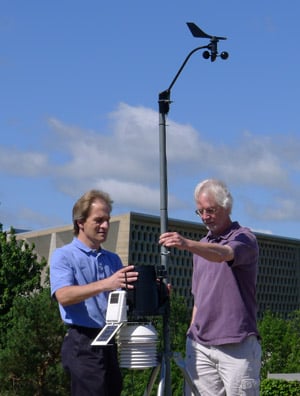Weather from the roof
New weather station gives students, faculty and public updated local information, research possibilities
June 25, 2012
By Mike Killeen

Batman and Robin are the Dynamic Duo of crime fighting. Stephen Saupe and Paul Beniek are the Dynamic Duo of weather reporting at the College of Saint Benedict and Saint John's University.
The two members of the CSB and SJU community are the masterminds behind a weather station located on the roof of the Peter Engel Science Center at SJU.
It's truly a dynamic duo, with both contributing to the success of the station.
"When the bad storms come, I'm the person outside," said Beniek, a client administrator for information technology services at CSB and SJU. "I'm also a gadget guy."
"I'm more of a 'Give me the data kind of guy.' You can put me in the general nerd camp, but not in the weather nerd camp. I'm more of a data nerd," said Saupe, professor of biology at CSB and SJU.
Both are continuing a long tradition of weather observation at SJU. Abbot Peter Engel, OSB, (for whom the Science Center is named) began weather observation for the National Weather Service (NWS) on Oct. 12, 1892, at SJU. Later, the Rev. Melchior Freund, OSB, served as the NWS weather recorder as a seminarian from 1951-57, and then again from 1968-2004. The NWS honored Freund in 2001 with the Cooperative Observer Award. Br. Bradley Jenniges, OSB, and - most recently - Br. Neal Laloo, OSB, have continued reporting data to the NWS from a ground unit near Emmaus Hall.
Somewhere around 2004, a new weather station was purchased that was also placed on the roof of the Science Center. And almost immediately, problems arose.
"We had all sorts of issues with it," Saupe said. "All I knew was the thing was down, and I hoped that Paul would come over and fix it."
Beniek said the majority of the problem "was the reception. The weather station was on the roof, and reported to a personal computer (PC), or data logger, wirelessly. The problem was that we would lose reception for large amounts of time, and that was because where the PC was located - right under the weather station. The signal couldn't carry through the cement ceiling and cement walls all the time."
They also found that whenever a storm caused the power to go off even temporarily, the PC would go out.
"We could never get the quality out of the system, because of all the outages," Beniek said. "When you're conducting research, you want consistency, and it has to be running all the time. With those outages, we would lose that. It really wasn't accurate data."
"It seemed like Paul was over here once a week, or so it seemed, trying to keep that station up and running," Saupe said.
Finally, both Saupe and Beniek figured enough was enough.
"I got the idea, 'You know what? We might as well just get a new station that will actually work,' " Saupe said. "We wrote a faculty development grant for getting the new equipment, and we were lucky enough to get the money."
With the aid of an internal faculty development grant, they purchased a Davis Wireless Vantage Pro2 Plus 6163 weather station. Beniek said they added boosters to strengthen the signal, and moved the PC near a window in Saupe's office, which is directly below the weather station, to avoid the problems that had plagued them with the previous unit.
"We fired everything up, and I've been there once since we actually put it up. The thing is just running beautifully," Beniek said.
The station runs by solar power during the day, and on a small battery at night. Data is collected roughly every two seconds and is uploaded to its website every five-to-seven seconds. The station includes an anemometer, rain gauge, thermo-hydro sensor and a solar sensor situated in optimal positions for highest accuracy possible.
Saupe has used the data collected by the station in his classes. Last semester, his plant physiology class used data to see if there were any connections between weather-related factors and maple syrup flow ("the simple answer was no," Saupe said). He's also planning on having a future introductory biology class conduct an analysis of the data.
At least two other CSB and SJU professors are also using data gathered from the weather station. Students of Manuel Campos, professor of biology, are using data on solar radiation in research looking at the vitamin D status of athletes and its correlation to measures of aerobic and anaerobic performance. Thomas Kirkman, associate professor of physics, is also using it in his teaching.
"Having gotten the grant money to replace the old station, it's really nice having a reliable system," Saupe said. "The only thing I don't like about the new station is it means I don't get to see Paul as much because he was over here on a regular basis (fixing the old station). That's the bittersweet part of it. But, it's still nice to gain a new colleague across campus."
View the data from the weather station as shown on the CSB/SJU website.
